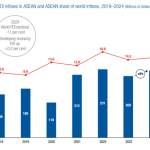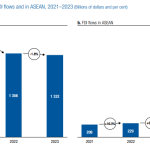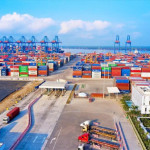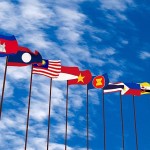Total number of posts 26.
 According to data from the Ministry of Industry and Trade, the total export turnover taking advantage of tariff preferences under the FTAs in 2020 reached 52.76 billion USD, accounting for 33.1% of the total export turnover to the markets which signed FTAs with Vietnam. In 2020, nearly 1 million preferential C/O sets were issued (including under FTA and GSP), increased 6% in value and 9% in the number of C/O sets compared to 2019.
According to data from the Ministry of Industry and Trade, the total export turnover taking advantage of tariff preferences under the FTAs in 2020 reached 52.76 billion USD, accounting for 33.1% of the total export turnover to the markets which signed FTAs with Vietnam. In 2020, nearly 1 million preferential C/O sets were issued (including under FTA and GSP), increased 6% in value and 9% in the number of C/O sets compared to 2019.
In terms of turnover taking advantage of tariff preferences, Vietnamese goods exported to China ranked first with the value of 15.52 billion USD, followed by Vietnamese goods exported to South Korea and ASEAN with the value of 9.95 billion USD and 8.97 billion USD respectively. The volume of exported goods taking advantage of tariff preferences from Vietnam to Laos, Cambodia and Cuba is negligible.
Regarding utilisation rate of FTA tariff preferences: The Indian market accounts for the highest percentage of AIFTA utilization with 70%; followed by markets in Chile and South Korea with 65.5% and 52.1% respectively. Regarding utilization rate of FTA tariff preferences from Laos (11.4%) and Cambodia (0.01%) is not high because Laos and Cambodia are both ASEAN members, so businesses often take advantage of tariff preferences directly from the ATIGA Agreement. Generally, utilization rate of FTA tariff preferences of Vietnam in 2020 is 33.1%. Although the rate of using C/O when exporting to some FTA markets might decrease, the number of applications for preferential C/O steadily increased year by year.
The rate of using preferential C/O is 33.1%, which does not mean that nearly 67% of the remaining export turnover of Vietnam is subject to high tariff. In fact, the MFN import tariff in some markets has been already 0%, or at a very low level of 1-2%, or equivalent to the special preferential rates under the FTA. In these cases, the enterprise does not apply for a preferential C/O when exporting because the presence or absence of a preferential C/O does not make a difference in tariff. For example, the export turnover to Singapore using C/O form D in 2020 reached 234 million USD, accounting for only about 7.7% of the total export turnover of 3.05 billion USD to this market, the main reason is Singapore’s MFN tariff is already 0%, so businesses do not need to apply for a preferential C/O when exporting. Similarly, Australia and New Zealand imposed 0% MFN tariff on many seafood products, so Vietnam's seafood products do not need C/O when exporting to these two countries.
The turnover issued C/O form CPTPP in 2020 reached 1.37 billion USD, equaling 4.02% of total export turnover to 6 member countries that ratified the CPTPP Agreement. The rate of using C/O form CPTPP when exporting to these markets is not high because most partner countries had FTA with Vietnam with looser rules of origin and more preferential tariff than CPTPP in the first years when CPTPP takes effect. For the two countries Mexico and Canada with the first FTA with Vietnam, the C/O turnover is quite high with $ 867.3 million and $ 402 million respectively, accounting for about 27.45% and 9.2% of total export turnover to these two markets.
After 5 months of implementing EVFTA, the total value of C/O form EUR.1 issued to goods exported to EU27 and the UK reached 2.66 billion USD, equal to about 14.83% of the total export turnover to this market in last 5 months of 2020. In the coming time, the ratio of using preferential C/O in total export turnover may increase even more because the EU market now still exists in parallel with 02 incentives GSP and EVFTA, so enterprises still apply both mechanisms when exporting goods to the EU and choose C/O form EUR.1 or C/O form A or self-certification of origin under the REX mechanism to enjoy tariff preferences under the corresponding mechanism when exporting to the EU.
In terms of product structure: In the group of industrial products, the total turnover of footwear issued preferential C/O reached about 7.33 billion USD, decreased about 24% compared to 2019. The decrease in C/O turnover of is from Korea, Japan, ASEAN markets, corresponding to the decline in footwear exports to these markets. Origin criteria for footwear in FTAs are assessed to be suitable with the ability of Vietnamese enterprises to meet. Therefore, footwear is always the commodity with high rate of using preferential C/O when exporting to FTA markets. For some markets, this ratio is 100%, which means that 100% of export shipments used preferential C/O. Followed by textile and garment products which has granted preferential C/O export turnover of 7.3 billion USD, accounting for 59% of the total export turnover of this commodity group to FTAs markets. Rubber and rubber products has granted preferential C/O export turnover 1.82 billion USD, increased 26.5% compared to 2019, equaling about 70% of the total export turnover of these products to other market having FTAs with Vietnam.
Many items in the group of agricultural and aquatic products has the high rate of using preferential C/O when exported to FTA markets such as seafood (68%), rice (68%), and pepper (65%). and coffee (48%).
The summary of the utilization rate of preferential C/O under Vietnam's FTAs over the years to 2020 (Vietnamese) is attached here.














